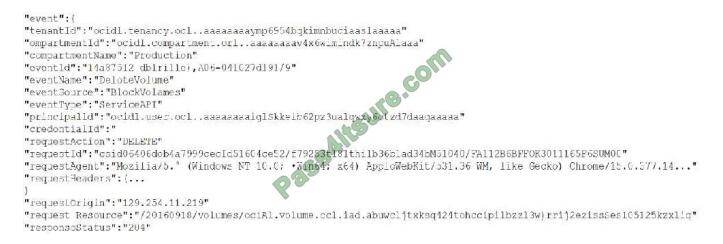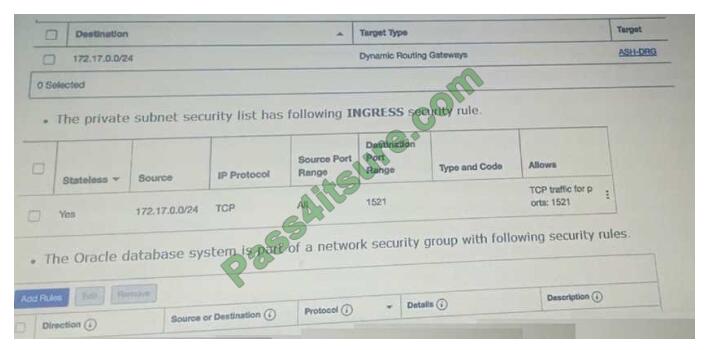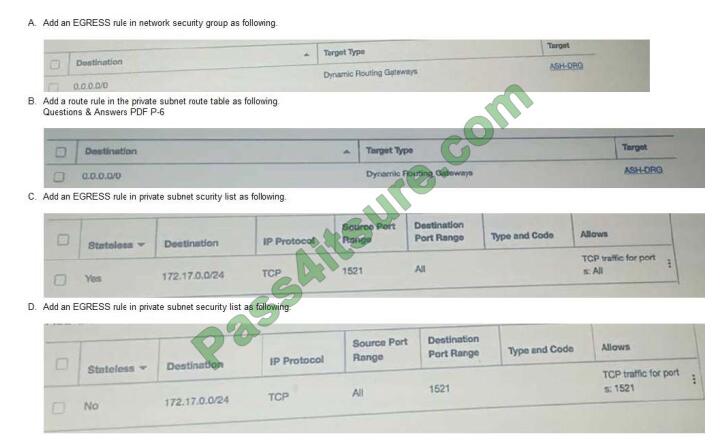Released the latest Oracle 1Z0-997 exam dumps! You can get 1Z0-997 VCE dumps and 1Z0-997 PDF dumps from Pass4itsure, (including the latest 1Z0-997 exam questions), which will ensure that your 1Z0-997 exam is 100% passed! Pass4itsure 1Z0-997 dumps VCE and PDF — https://www.pass4itsure.com/1z0-997.html Updated!
Oracle 1Z0-997 Exam Dumps
[100% free] 1Z0-997 pdf dumps https://drive.google.com/file/d/1U6H8M5hGTbGtoekzvQ1m4vYUCaQ-Upgl/view?usp=sharing
Oracle Cloud 1Z0-997 Practice Test 1-13
Another thing that can prove very helpful in preparing for the 1Z0-997 exam is the 1Z0-997 practice test.
QUESTION 1
You have deployed a web application targeting a global audience across multiple Oracle Cloud Infrastructure (OCI)
regions.
You decide to use Traffic Management Geo-Location based Steering Policy to serve web requests to users from the
region closets to the user. Within each region you have deployed a public load balancer with 4 servers in a backend
set.
During a DR test disable all web servers in one of the regions however, traffic Management does not automatically
direct all users to the other region.
Which two are possible causes?
A. You did not setup a Route Table associated with load Balancer\\’s subnet
B. You did not setup an HTTP Health Check associated with Load Balancer public IP in the disabled region.
C. Rather than using Geo-Location based Steering Policy, you should use Failover Policy Type to serve traffic.
D. One of the two working web servers In the other region did not pass Its HTTP health check
E. You did not correctly setup the Load Balancer HTTP health check policy associated with backend set
Correct Answer: BE
Managing Traffic Management GEOLOCATION Steering Policies Geolocation steering policies distribute DNS traffic to
different endpoints based on the location of the end user. Customers can define geographic regions composed of
originating continent, countries or states/provinces (North America) and define a separate endpoint or set of endpoints
for each region. The Health Checks service allows you to monitor the health of IP addresses and hostnames, as
measured from geographic vantage points of your choosing, using HTTP and ping probes. After configuring a health
check, you can view the monitor\\’s results. The results include the location from which the host was monitored, the
availability of the endpoint, and the date and time the test was performed. Also, you can Combine Managing Traffic
Management GEOLOCATION Steering Policies with Oracle Health Checks to failover from one region to another The
Load Balancing service provides health status indicators that use your health check policies to report on the general
health of your load balancers and their components. if you misconfigure the health check Protocol between the Load
balancer and backend set that can lead to not get an accurate response as the example below
If you run a TCP-level health check against an HTTP service, you might not get an accurate response. The TCP
handshake can succeed and indicate that the service is up even when the HTTP service is ly configured or having other
issues. Although the health check appears good customers might experience transaction failures.
QUESTION 2
A customer has a Virtual Machine instance running in their Oracle Cloud Infrastructure tenancy. They realized that they
wrongly picked a smaller shape for their compute instance. They are reaching out to you to help them fix the issue.
Which of the below options is best recommended to suggest to the customer?
A. Delete the running instance and spin up a new instance with the desired shape.
B. Change the shape of the instance without reboot but stop all the applications running on the instance beforehand to prevent
data corruption.
C. Change the shape of the virtual machine instance using the Change Shape feature available in the console.
D. OCI doesn\\’t allow such an operation.
Correct Answer: C
You can change the shape of a virtual machine (VM) instance without having to rebuild your instances or redeploy your
applications. This lets you scale up your Compute resources for increased performance, or scale down to reduce cost.
When you change the shape of an instance, you select a different processor, a number of cores, amount of memory,
network bandwidth, and maximum number of VNICs for the instance. The instance\\’s public and private IP addresses,
volume attachments, and VNIC attachments remain the same.
QUESTION 3
You are helping a customer troubleshoot a problem. The customer has several Oracle Linux servers in
Based on cost considerations, which option will fix this Issue?
A. Create a Public Load Balancer In front of the servers and add the servers to the Backend Set of the Public Load
Balancer.
B. Create another Internet Gateway and configure it as a route target for the private subnet.
C. Implement a NAT instance In the public subnet of the VCN and configure the NAT instance as the route target for the
private subnet.
D. Create a NAT gateway in the VCN and configure the NAT gateway as the route target for the private subnet.
Correct Answer: A
QUESTION 4
As a part of the migration exercise for an existing on-premises application to Oracle Cloud Infrastructure (OCT), yon ore
required to transfer a 7 TB file to OCI Object Storage. You have decided to upload the functionality of Object Storage.
Which two statements are true?
A. Active multipart upload can be checked by listing all parts that have been uploaded, however, It Is not possible to list
information for individual object part in an active multipart upload
B. It is possible to spill this file into multiple parts using the APIs provided by Object Storage.
C. It is possible to split this file into multiple parts using clone tool provided by Object Storage.
D. After initiating a multipart upload by making a CreateMultlPartUpload RESI API Call, the upload remains active until
you explicitly commit it or abort.
E. Contiguous numbers need to be assigned for each part so that Object Storage constructs the object by ordering, part
numbers in ascending order
Correct Answer: AD
You can check on an active multipart upload by listing all parts that have been uploaded. (You cannot list information for
an individual object part in an active multipart upload.) After you finish creating object parts, initiate a multipart upload by making a CreateMultipartUpload REST API call. Provide the object name and any object metadata. Object Storage
responds with a unique upload ID that you must include in any requests related to this multipart upload. Object Storage
also marks the upload as active. The upload remains active until you explicitly commit it or abort it.
QUESTION 5
An automobile company wants to deploy their CRM application for Oracle Database on Oracle Cloud Infrastructure
(OC1) DB Systems for one of the major clients. In compliance with the Business Continuity Program of the client, they need
to provide a Recovery Point Objective (RPO) of 24 hours and a Recovery time objective (RTO) of 24 hours and
Recovery Time Objective (RTO) of 1 hour. The CRM application should be an available oven in my event that entire on
The region is down. Which approach Is the most suitable and cost-effective configuration for this scenario?
A. Deploy a 1 node VM Oracle database in one region and replicate the database to a 1 node VM Oracle database in
another region using a manual setup and configuration of Oracle Data Guard.
B. Deploy a 2 node Virtual Machine (VM) Oracle RAC database in one region and replicate the database to a 2 node
VM Oracle RAC database in another region using a manual setup and
C. Deploy a 1 node VM Oracle database in one region. Manual Configure a Recovery Manager (RMAN) database
backup schedule to take hourly database backups. Asynchronously copy the database backups to object storage in
another OCI region, If the primary OCI region is unavailable launch a new 1 new VM Database in the other OCI region
to restore the production database from the backup.
D. Deploy an Autonomous Transaction Processing (Serverless) database in one region and replicate it to an
Autonomous Transaction Processing (Serverless) database in another region Oracle GoldenGate.
Correct Answer: A
You can configure the Autonomous Database instance as a target database for Oracle GoldenGate. But You can\\’t set
up Oracle Autonomous Database as a source database for Oracle GoldenGate. Recovery Point Objective (RPO) of 24
hours and Recovery Time Objective (RTO) of 1 hour
-To provision new VM and restore the production database from the backup on object storage, will exceed the RTO 1
hour
– You can create the standby DB system in a different availability domain from the primary DB system for availability and
disaster recovery purposes. With Data Guard and switchover/failover can meet RTO 1 hour.
-RAC Database is not required in this solution. Standalone will be most suitable and cost-effective
QUESTION 6
Your team is conducting a root analysis (RCA) following a recent, unplanned outage. One of the block volumes attached
to your production WebLogic server was deleted and you have tasked with identifying the source of the action. You
search the Audit logs and find several Delete actions that occurred in the previous 24 hours. Given the sample of this
event.

Which item from the event log helps you identify the individual or service that initiated the DeleteVolume API call?
A. requestAgent
B. eventource
C. principalld
D. requestOrigin
E. eventId
Correct Answer: C
The Oracle Cloud Infrastructure Audit service automatically records calls to all supported Oracle Cloud Infrastructure
public application programming interface (API) endpoints as log events.
Currently, all services support logging by Audit.
Every audit log event includes two main parts:
Envelopes that act as a container for all event messages Payloads that contain data from the resource emitting the
event message The identity object contains the following attributes. data.identity.authType The type of authentication
used.
data.identity.principalId The OCID of the principal.
data.identity.principalName The name of the user or service. This value is the friendly name associated
with principalId .
QUESTION 7
To serve Web traffic for a popular product, your cloud engineer has provisioned four BM.Standard2.52 instances, the event
spread across two availability domains in the us-auburn-1 region:
LoadBalancer is used to deliver traffic across instances. After several months, the product grows even more popular
and you need additional computing capacity. As a result, an engineer provisioned two additional VM.Standard2.8
instances. You register the two VM. Standard2. 8 Instances with your Load Balancer Backend sot and quickly find that the VM Standard2.8 Instances running at 100% of CPU utilization but the BM.Standard2 .52 instances have significant
CPU capacity that\\’s unused. Which option is the most cost-effective and uses instances capacity most effectively?
A. Configure your Load Balance, with a weighted round-robin policy to distribute traffic to the compute instances, with
more weight assigned to bare metal instances.
B. Configure Autoscaling instance pool with LoadBalancer to add up to 3 more BM.Standard2.52 Instances when
triggered. Shut off VM.Standard2.8 instances.
C. Route traffic to BM.Standard2.52 and VM Standard2.8 instances directly using DNS and Health Checks. Shut off the
load Balances.
D. Configure LoadBalancer with two VM Standard2.8 instances and use the Autoscaling Instant pool to add up to two
additional VM instances. Shut off BM.Standard2.52 instances.
Correct Answer: A
The customer has 4 BM.Standard2.52 and After several months he needs additional compute capacity customer find The
VM Standard2.8 Instances running at 100% of CPU utilization but the BM.Standard2 .52 instances have significant CPU
capacity that unused. so the customer need to check the load balance policy to make sure the 4 BM and VM is utilizing
correctly
QUESTION 8
A large London based eCommerce company is running Oracle DB System Virtual RAC database on Oracle Cloud
Infrastructure (OCI) for their eCommerce application activity. They are launching a new product soon, which is expected
to sell in large quantities all over the world. The application architecture should have minimal cost, no data loss, no
performance impacts during the database backup windows, and should have minimal downtime.
A. Launch a new VM RAC database in another availability domain, launch a compute instance, deploy Oracle
GoldenGate on it and then configure it to replicate the data from the eCommerce Database over to the new RAC
database using GoldenGate. Take backups from the new VM RAC database.
B. Turn off automated backups from the eCommerce database, implement Oracle Data Guard with the Standby
database deployed on another availability domain, take backups from the standby database.
C. Launch a new VM RAC database in another availability domain, launch a compute instance, deploy Oracle
GoldenGate on it and then configure bi-directional replication from the eCommerce Database over to the new VM RAC
database using GoldenGate. Take backups from the new VM RAC database.
D. Turn off automatic backups from the eCommerce database, implement Oracle Active Data Guard with the standby
database deployed on another availability domain, and take backups from the standby database.
Correct Answer: C
Active Data Guard or GoldenGate are used for disaster recovery when fast recovery times or additional levels of data
protection is required. And offload queries and backup to the standby system. Oracle GoldenGate to support a disaster
recovery site is to have a working bi-directional data flow, from the primary system to the live-standby system and vice
versa.
DataGuard and Automatic Backup
You can enable the Automatic Backup feature on a database with the standby role in a Data Guard association. However, automatic backups for that database will not be created until it assumes the primary role.
QUESTION 9
You work for a German company as the Lead Oracle Cloud Infrastructure architect. You have designed a highly
scalable architecture for your company\\’s business-critical application which uses the Load Balancer service auto which
uses the
Load Balancer service, autoscaling configuration for the application servers, and a 2 Node VM Oracle RAC database.
During the peak utilization period of the- application yon notice that the application is running slow and customers are
complaining. This is resulting in support of tickets being created for API timeouts and negative sentiment from the
customer base.
What are two possible reasons for this application’s slowness?
A. Autoscaling configuration for the application servers didn\\’t happen due to 1 AM policy that\\’s blocking access to the
application server compartment
B. The Load Balancer configuration is not sending traffic to the listener of the application servers.
C. Autoscaling configuration for the application servers didn\\’t happen due to compartment quota breach of the VM
shapes used by the application servers.
D. Autoscaling configuration for the application servers didn\\’t happen due to service limit breach of the VM shapes
used by the application servers
E. The Load Balancer doesn\\’t have a Network Security Group to allow traffic to the application servers.
Correct Answer: CD
Autoscaling enables you to automatically adjust the number of Compute instances in an instance pool
based on performance metrics such as CPU utilization. This helps you provide consistent performance for your end-users during periods of high demand, and helps you reduce your costs during periods of low demand. Prerequisites
–
You have an instance pool. Optionally, you can attach a load balancer to the instance pool. For steps to create an
instance pool and attach a load balancer, see Creating an Instance Pool.
–
Monitoring is enabled on the instances in the instance pool. For steps to enable monitoring, see Enabling Monitoring for
Compute Instances.
–
The instance pool supports the maximum number of instances that you want to scale. This limit is determined by
your tenancy\\’s service limits. About Service Limits and Usage When you sign up for Oracle Cloud Infrastructure, a set
of service limits are configured for your tenancy. The service limit is the quota or allowance set on a resource. For
example, your tenancy is allowed a maximum number of compute instances per availability domain. These limits are
generally established with your Oracle sales representative when you purchase Oracle Cloud Infrastructure.
Compartment Quotas Compartment quotas are similar to service limits; the biggest difference is that service limits are
set by Oracle, and compartment quotas are set by administrators, using policies that allow them to
QUESTION 10
You have provisioned a new VM.DenseIO2.24 compute instance with local NVMe drives. The compute instance is
running a production application. This is a write-heavy application, with a significant impact on the business if the
application goes down. What should you do to help maintain write performance and protect against NVMe device’s
failure?
A. NVMe drive has built-in capability to recover themself so no other actions are required
B. Configure RAID 6 for NVMe devices.
C. Configure RAID 1 for NVMe devices.
D. Configure RAID 10 for NVMe devices.
Correct Answer: D
VM.DeselO2.24 compute instance include locally attached NVMe devices. These devices provide extremely low
latency, high-performance block storage that is ideal for big data, OLTP, and any other workload that can benefit from
high-performance block storage. A protected RAID array is the most recommended way to protect against an NVMe
device failure. There are three RAID levels that can be used for the majority of workloads: RAID 1: An exact copy (or
mirror) of a set of data on two or more disks; a classic RAID 1 mirrored pair
QUESTION 11
An upcoming e-commerce company has deployed its online shopping application on OCI. The application was
deployed on compute instances with autoscaling configuration for application servers fronted by a load balancer and
OCI Autonomous Transaction Processing (ATP) in the backend. In order to promote their e-commerce platform 50%
the discount was announced on all the products for a limited period. During day 1 of the promotional period, it was observed
that the application is running slow and the company\\’s hotline is flooded with complaints. What could be two possible
reasons for this situation?
A. The health check on some of the backend servers has failed and the load balancer has taken those servers
temporarily out of the rotation
B. As part of autoscaling, the load balancer shape has dynamically changed to a larger shape to handle more incoming
traffic and the system was slow for a short time during this change
C. The health check on some of the backend servers has failed and the load balancer was rebooting these servers.
D. The autoscaling has already scaled to the maximum number of instances specified in the configuration and there is
no room for scaling
Correct Answer: AD
QUESTION 12
You have an Oracle database system in a virtual cloud network (VCN) that needs to be accessible on port 1521 from
your on-premises network CIDR 172.17.0.0/24.
You have the following configuration currently.
Virtual cloud network (VCD) is associated with a Dynamic Routing Gateway (DRG), and DRG has an active IPSec
connection with your on-premises data center.
Oracle database system is hosted in a private subnet
The private subnet route table has the following configuration The private subnet route table has the following
configuration.
However, you are still unable to connect to the Oracle Database system. Which action will resolve this issue?

A. Option A
B. Option B
C. Option C
D. Option D
Correct Answer: C
QUESTION 13
Your organization is planning on using Oracle Cloud Infrastructure (OCI) File Storage Service (FSS). You will be
deploying multiple compute instance in Oracle Cloud Infrastructure (OCI) and mounting the file system to these
compute
instances. The file system will hold payment data processed by a Database instance and utilized by compute instances
to create an overall inventory report. You need to restrict access to this data for specific compute instances and must be
allowed/blocked per compute instance\\’s CIDR block.
Which option can you use to secure access?
A. Use stateless Security List rule to restrict access from known IP addresses only.
B. Create a new VCN security list, choose SOURCE TYPE as Service, and SOURCE SERVICE as FSS. Add statelessly
ingress and egress rules for specific P addresses and CIDR blocks.
C. Use \\’Export option\\’ feature of FSS to restrict access to the mounted file systems.
D. Create and configure OCI Web Application Firewall service with built-in DNS based intelligent routing.
Correct Answer: C
NFS export options enable you to create more granular access control than is possible using just security list rules to
limit VCN access. You can use NFS export options to specify access levels for IP addresses or CIDR blocks connecting
to file systems through exports in amount target. Access can be restricted so that each client\\’s file system is
inaccessible and invisible to the other, providing better security controls in multi-tenant environments. Using NFS export
option access controls, you can limit clients\\’ ability to connect to the file system and view or write data. For example, if
you want to allow clients to consume but not update resources in your file system, you can set access to Read Only.
You can also reduce client root access to your file systems and map specified User IDs (UIDs) and Group IDs (GIDs) to
an anonymous UID/GID of your choice. For more information about how NFS export options work with other security
layers
Pass4itsure Discount Code 2020
Please read the picture carefully to get 12% off!

P.S.
Passing the Oracle 1Z0-997 exam is no more dream. Free share all the resources: Latest 1Z0-997 practice questions, latest 1Z0-997 pdf dumps, 1Z0-997 exam video learning. Visit https://www.pass4itsure.com/1z0-997.html exam dumps with the latest questions.
